NRAO eNews
Volume 8, Issue 8
7 October 2015
NRAO eNews
Volume 8, Issue 8 • 7 October 2015

Next Generation VLA Workshop at the January AAS meeting
The NRAO is organizing a one-day workshop on Monday, 4 January 2016 to discuss the scientific motivation and technical concept for a next generation Very Large Array (ngVLA). This workshop will take place immediately prior to the January 2016 American Astronomical Society (AAS) meeting in Kissimmee, Florida, and will update the astronomical community on progress toward the ngVLA concept.
This ngVLA Workshop will foster broad community discussion of the ngVLA science case and technical challenges and will include:
- Presentation of current scientific drivers for the ngVLA by community leaders;
- Contributed science talks that expand the ngVLA science case;
- Discussion of the technical requirements and challenges emerging from the science program;
- Discussion of ngVLA synergies with other science facilities, such as the Atacama Large Millimeter/submillimeter Array, James Webb Space Telescope, High Definition Space Telescope, Square Kilometre Array, and Thirty Meter Telescope.
This ngVLA Workshop will span a full day (9 a.m. – 5 p.m. EST).
Please visit the ngVLA Workshop 2016 website for additional information. We request attendees register at the Workshop website so that we can adequately plan for seating and refreshments, but registration is not required to attend.
We look forward to seeing everyone in Kissimmee on Monday, 4 January 2016!
Registration Open for U.S. Radio Futures Conference
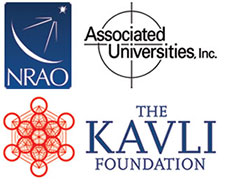
Registration is now open for the first of three conferences that will provide the community broad opportunities to discuss potential U.S. futures for radio-millimeter-submillimeter (RMS) science in the 2020’s and beyond. This conference will take place 15-17 December 2015 in Chicago, Illinois.
Funded by Associated Universities, Inc. (AUI) and the Kavli Foundation, and organized by the NRAO, this conference is structured around key science themes that reflect priorities identified in the New Worlds, New Horizons Decadal Survey and that require observations at RMS wavelengths to address.
The Science Organizing Committee co-chairs are Mark Reid (CfA) and Jean Turner (UCLA). Science Working Groups (SWGs) have been formed to address how next-generation RMS facilities will enable new science and discovery relevant to four major science themes.
Cradle of Life
Led by Lee Hartmann (Michigan) & Dave Wilner (CfA).
This Working Group will address science questions such as how stars form, how circumstellar disks form and evolve, and how planetary systems develop within circumstellar disks.
Formation and Evolution of Galaxies
Led by Alice Shapley (UCLA) & Min Yun (UMass).
This Working Group will address science questions such as how gas flows into and out of galaxies, the extent to which galaxy interactions can be tracked, and how our Galaxy and galaxies in the Local Group serve as models for galaxies across the Universe.
Fundamental Physics
Led by Avery Broderick (Waterloo) & Maura McLaughlin (WVU).
This Working Group will address science questions regarding how the Universe can be used as a laboratory for testing the extremes of physical laws including relativistic magneto-hydrodynamics, testing nuclear equations of state, physics near event horizons, and theories of gravity.
Cosmology & Cosmic Dawn
Led by John Kovac (Harvard) & Sarah Church (Stanford).
This Working Group will address science questions regarding the extent to which the early Universe can be probed and how the Universe made the transition from a largely neutral state to a largely ionized state.
Please visit the conference website to register and for additional information.
We hope you will join us in Chicago 15-17 December for this important and exciting discussion of the future of U.S. radio-millimeter-submillimeter science.
Upcoming Events

Observational Evidence of Gas Accretion onto Galaxies?
Oct 9 - 10, 2015 | Charlottesville, VA

4th China – U.S. Workshop on Radio Astronomy Science & Technology
Oct 14 - 16, 2015 | Shanghai, China

Jansky Fellowship Application Deadline
Nov 2, 2015

Science at Low Frequencies II Workshop
Dec 2 - 4, 2015 | Albuquerque, NM

U.S. Radio – Millimeter – Submillimeter Science Futures Conference
Dec 15 - 17, 2015 | Chicago, IL

Next Generation Very Large Array Workshop
Jan 4, 2016 | Kissimmee, FL

NRAO Town Hall at Jan 2016 AAS Meeting
Jan 7, 2016 | Kissimmee, FL

AAAS 2016: Planet Formation With Radio Eyes
Feb 13, 2016 | Washington, DC
CASA Pipeline for the VLA
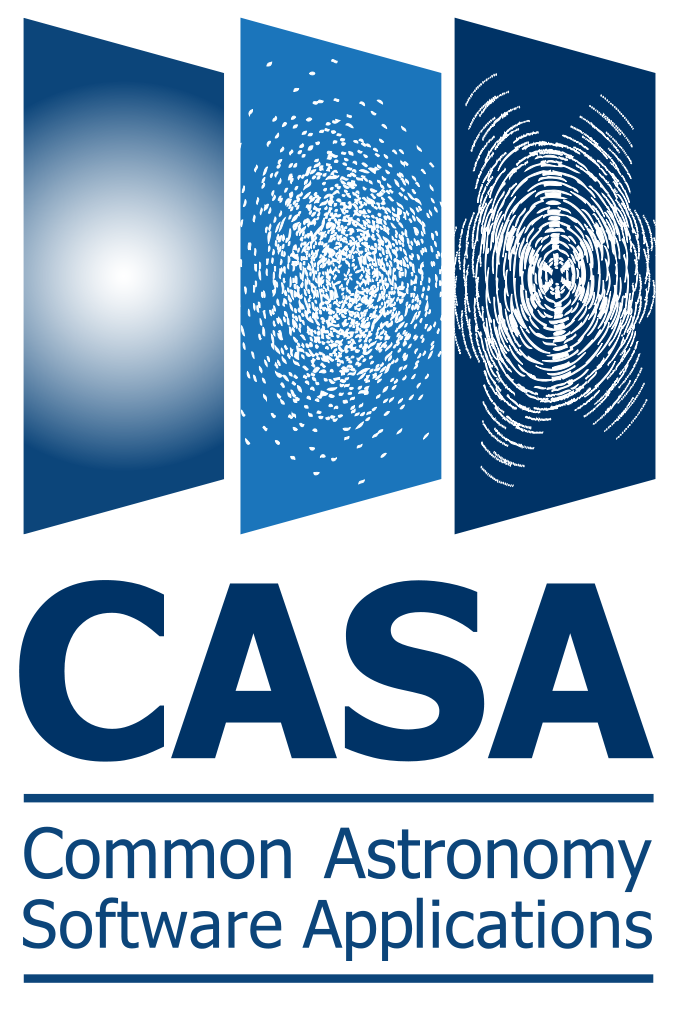
We are pleased to announce that, starting 8 September 2015, the Very Large Array (VLA) has transitioned to using the Common Astronomy Software Applications (CASA) pipeline. With this transition the VLA and Atacama Large Millimeter/submillimeter Array (ALMA) pipelines now provide a common user interface and similar weblog output. Instructions for using the CASA pipeline for VLA data are available on-line.
For convenience, the CASA pipeline is distributed for both OSX and Linux in an integrated package, requiring no additional downloads or files. The first version accepted for official use by the VLA is based on CASA-4.3.1 and is available for download from the CASA website.
The previous scripted pipeline version in production was based on CASA-4.2.2. Between these two versions of CASA, an error in flux interpolation was discovered and addressed in the underlying CASA implementation. This resulted in an offset in the flux density scale between the previous scripted pipeline and the current production pipeline. If you need to combine data from multiple observations or epochs it is safest to ensure that the data is all on the same flux scale by either re-processing previous executions using the CASA 4.3.1 based pipeline, or by continuing to use the scripted pipeline. As always, both options are supported either at your home institution or by using NRAO computing facilities.
ALMA Program News
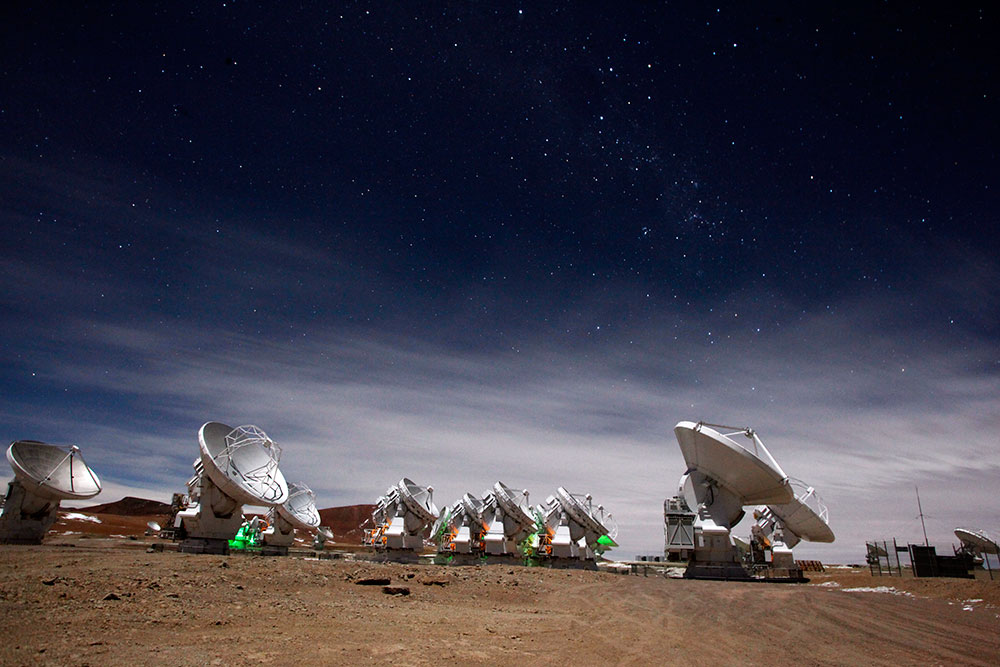
C. Padilla
[click to enlarge]
Cycle 2 & Cycle 1 Science Operations
ALMA’s program of Cycle 2 and Cycle 1 carryover observations concluded on 28 September. Over 80% of the time assigned for A- and B-ranked projects was successfully executed in addition to a number of C-ranked projects. In total, over 2000 hours of ALMA observations were executed, as planned for Cycle 2 with Cycle 1 carryover. In a message, the ALMA Director and Deputy Directors noted: “We would like to thank the hard work, expertise and commitment of all involved in this success both at the Joint ALMA Observatory and the ALMA Science Centers in East Asia, Europe, and North America. It is the combined efforts of all that lead to this successful outcome. We are looking forward to a new Cycle of observations that will start, for the first time, with PI science using the very long baseline configuration.”
The North American ALMA leadership noted that, in addition to the high completion rate of A- and B-ranked 12m proposals, more than 99% of the 7m and over 96% of the Total Power projects were finished. The North American ALMA leadership further noted that: “This Cycle featured the stunning results from the Long Baseline Campaign (LBC), for which North America made an outstanding contribution. Perhaps more than anything to date, the LBC results defined the power and potential of ALMA to a worldwide audience. A host of other groundbreaking publications have appeared on proto-planetary disks, the early universe, and other topics. In total, ALMA publications now stand at 280.”
Cycle 3 Science Operations
Cycle 3 – for which 402 proposals were highly ranked of 1578 submitted – began 1 October 2015 with antennas being moved to the C36-8 high-resolution configuration, with a maximum baseline of 9.7 km. In addition, of the 36 Cycle 2 A-ranked projects, 7 will be transferred to the Cycle 3 queue because they were not completed. Antennas are being moved for high-resolution Cycle 3 observations that are expected to begin 13 October 2015. Contact Scientists are already seeking Principal Investigator approval of schedule blocks for these observations. A detailed report on the results of the Cycle 3 proposal review process is available; the abstracts of accepted Cycle 3 proposals are also available at the Portal.
ALMA is now accepting requests for projects with urgent observing needs through its program of Director’s Discretionary Time (DDT). DDT proposals should conform to the capabilities available for the Cycle 3 Call for Proposals.
As announced in the Science Portal, the Extension and Optimization of Capabilities (EOC) Team at the Joint ALMA Observatory is anticipating the release of the ALMA commissioning test data taken towards Pluto in support of the NASA JPL New Horizons Mission. The data were taken in TDM mode in Band 7 over seven observing epochs. The ALMA Science Data Models and data reduction scripts will be available soon under the "Commissioning Test Data" section of the ALMA Science Portal Science Verification page.
New North American ALMA Regional Center Manager
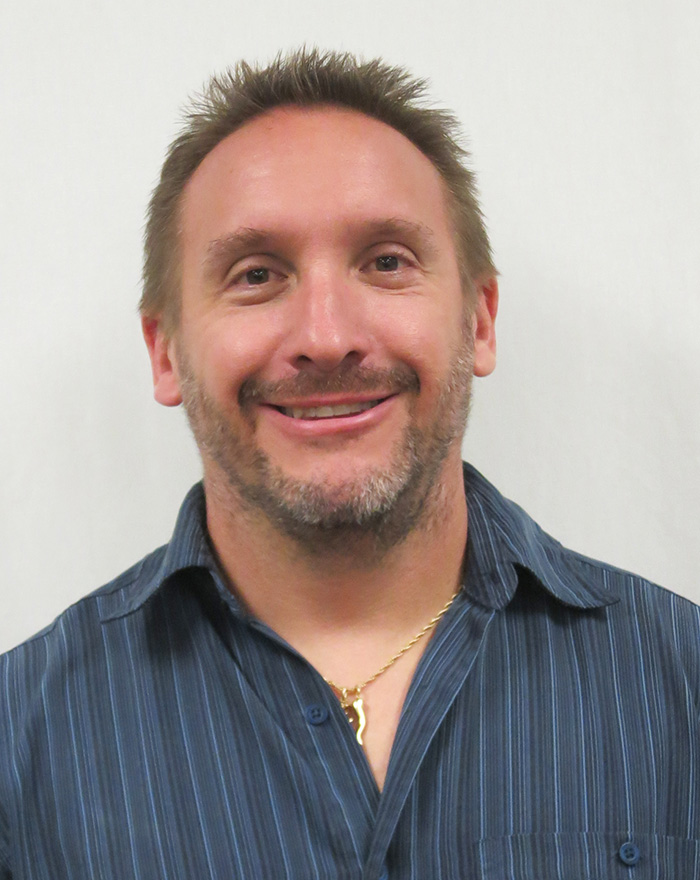
Anthony Remijan
[click to enlarge]
We are pleased to announce that Anthony Remijan became the new manager of the North America ALMA Regional Center (ARC) effective 1 October 2015, taking over from John Hibbard.
Tony comes to this new role after ten years at NRAO and the North American ALMA Science Center (NAASC), following postdoctoral work at NASA – Goddard and Ph.D. studies at the University of Illinois. Tony has held three prior and successful management roles at NRAO – head of the ALMA Helpdesk Working Group, Science User Support Division Head, and currently, ALMA Program Scientist for the Extension and Optimization of Capabilities Group at the Joint ALMA Observatory. He also led the Splatalogue development group and has participated in numerous other service roles. Tony’s science program focuses on the astrochemistry of large and biologically significant molecules, the study of cometary chemistry, and he has participated in numerous interstellar molecule discoveries and analyses.
We are grateful to John Hibbard for his long and extraordinary contributions as North American ARC Manager. John held this position since the inception of the ARC system, and he is one of the original authors of the ALMA Operations Plan that has served as the guidebook throughout ALMA’s early operations. John has been a leader in ALMA not only at the NA ARC, but in the development and execution of international policies, procedures, and processes. John is considering a number of roles within NRAO and will stay involved in the NAASC.
Please join us in welcoming Tony into his new position as NA ARC Manager, and in thanking John for his long and excellent service in the position.
North American ALMA Computing Cluster for Remote Use
The NRAO North American ALMA Science Center (NAASC), located at NRAO headquarters in Charlottesville, Virginia, is pleased to announce the general availability of its 64 node post-processing cluster for remote use by investigators. Access is limited to observers with current User Database entries. Observers with projects delivered in the last six months will receive priority access. The cluster is a finite resource, so access cannot be guaranteed.
Documentation describing the process for requesting resources and utilizing assigned resources is online. The computing cluster is intended for ALMA data processing using the Common Astronomy Software Applications (CASA) package.
An Innovative Sinuous Antenna
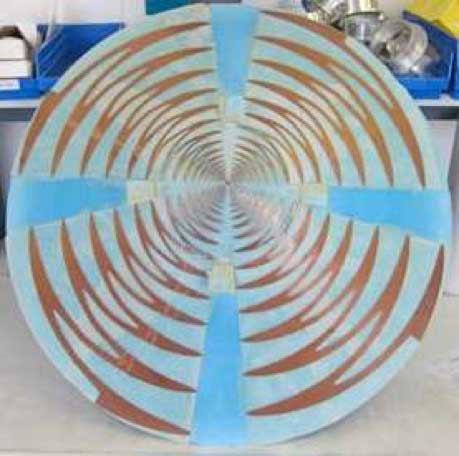
Fig. 1: Sinusoidal resonators embedded onto an inverted cone. This feed functions from 300 MHz to 3 GHz.
[click to enlarge]
Research conducted at the NRAO Central Development Laboratory (CDL) has led to an innovation in wide-band radio antennas. This breakthrough technology combines traditional and new techniques to create an antenna or an antenna feed with exceptional simultaneous frequency coverage, such as an antenna that can cover a 10:1 frequency range. The patented invention is suitable for moderately low-noise systems, where wide bandwidth requirements are a priority.
A working prototype antenna covers the 300 MHz to 3 GHz range, but the invention can be implemented in any range of radio frequencies, such as 2-20 GHz, which may have a significant impact on commercial satellite communications and related uses. The patent describes the design and placement of specifically shaped sinuous resonators onto the surface of an inverted cone sitting atop a traditional ground plane. This new invention avoids the need for absorbers and other signal directing devices, which typically add unwanted noise.
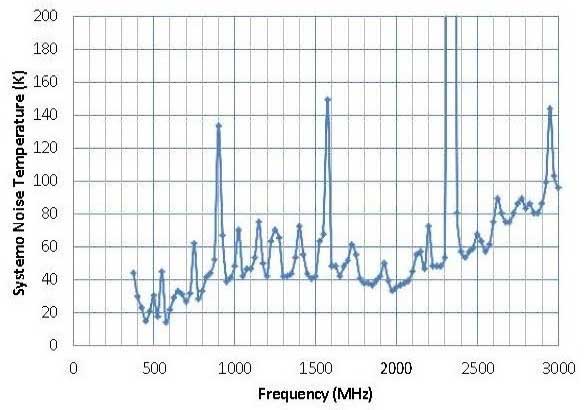
Fig. 2: This new wide bandwidth technology simultaneously enables, in this example, good reception from four commercial services (900, 1100, 2300 & 2900 MHz).
[click to enlarge]
Resonators that are shaped and placed according the patented design are always at one quarter wavelength above the ground plane for any given frequency to provide proper tuning and a nearly frequency independent phase center. The radio signal return loss becomes favorable over a wide frequency range with minimal ripple effect. The wide instantaneous bandwidth can accommodate frequency agile applications such as a spread spectrum radio, simultaneous multiple narrow channels, or ultra-wideband pulse communications. Using this technique allows one antenna to replace many antennas in practical use, as well as replacing multiple receivers/transmitters with one software-defined radio that can accommodate a wide range of frequencies (e.g. 10:1 frequency range).
The applications of this technology include radio astronomy, biomedical imaging, spectrum surveillance, and satellite communications, among others. U.S. Patent #9,054,516 was issued on 9 June 2015 to NRAO researchers Richard Bradley and Rohit Gawande. The CDL supports the evolution of NRAO's existing facilities and provides the technology and expertise needed to build the next generation of radio astronomy instruments.
Recent Media Releases
Career Opportunities
Jansky Fellowship: The NRAO is now accepting applications for our Jansky Fellowship Program. The Jansky Fellowship Program supports outstanding postdoctoral scientists whose research is broadly related to the mission and scientific goals of the world-class research facilities operated by the NRAO: the Atacama Large Millimeter/submillimeter Array, Very Large Array, Very Long Baseline Array, and Green Bank Telescope. Prior radio-wavelength experience is not required and research that synergistically employs NRAO telescopes in multi-wavelength collaborations is encouraged. Candidates with interests in radio astronomy instrumentation, computation, and theory are also encouraged to apply.
Scientific Data Associate: The NRAO is now accepting applications for a Scientific Data Associate position in Charlottesville, VA. The North American ALMA Science Center is offering one or more scientific support appointments to experienced interferometric scientists to support the reduction and imaging of ALMA data and the training and support of ALMA research investigators. The positions are for two years, with the possibility of renewal for a third year based on performance and available funding. These positions are 100% support positions, with no defined research fraction, but successful candidates will have the opportunity to participate in NRAO science groups and workshops. Publication support is provided and a modest travel allowance is available to attend domestic science conferences.
For additional information on these openings and other NRAO career opportunities, please visit the NRAO – Career Opportunities web pages.
From the Archives
Ellen Bouton

[click to enlarge]
About this month's photograph: It's the 50th anniversary of the dedication of the 140-foot telescope! In this photo, NRAO Director David Heeschen speaks at the 13 October 1965 dedication ceremonies. Behind him on the podium are Theodore P. Wright (AUI Trustee), Leland J. Haworth (NSF Director), Max Small (NRAO 140-foot Project Manager), and T. Keith Glennan (AUI President). Even before the formal beginning of NRAO on 17 November 1956, there were discussions among astronomers about the design of the telescope, including extremely heated (yet still polite) disagreements about altitude-azimuth versus equatorial mounted designs. Groundbreaking was 14 August 1958, but early construction was slow and fraught with many difficulties. By the end of 1961, much to the relief of both AUI and NRAO staff, the construction process began to move smoothly forward. Although the actual dedication was not until October 1965, the telescope's first observations were Sebastian von Hoerner's observations of a 23 May 1965 lunar occultation of a radio source and, on 9 July 1965, Bertil Hoglund and Peter Mezger detected radio recombination lines. The dedication ceremonies ushered in a long and illustrious career for the 140-foot telescope.
From the Archives is an ongoing series illustrating NRAO and U.S. radio astronomy history via images selected from our collections of individuals' and institutional papers. If readers have images they believe would be of interest to the Archives, please contact Ellen Bouton.

